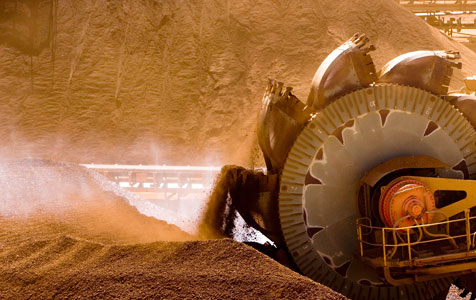The value of Australian iron ore exports is expected to fall next year as strong growth in production volumes is offset by a slump in prices to a forecast $US52.10 per tonne in 2016.


The value of Australian iron ore exports is expected to fall next year as strong growth in production volumes is offset by a slump in prices to a forecast $US52.10 per tonne in 2016.
In its quarterly resources and energy report, the federal government's Department of Industry and Science says it expects iron ore production volumes to rise by 7.6 per cent in 2015-16, while export values will fall by 3.9 per cent in nominal terms to $52.2 billion.
It estimated Australia’s overall resources and energy commodity exports declined by 11 per cent in 2014-15 to $174 billion.
“A decline in iron ore and metallurgical coal export earnings, which are estimated to have fallen by 27 per cent and 7 per cent respectively in 2014-15, were key drivers of the decline,” the report said.
The report said that, following the sharp fall in domestic production, the Chinese government announced a resources tax cut on locally mined iron ore of between $US3-6/t.
“This is not expected to be enough to make most of China’s iron ore producers competitive with low cost seaborne suppliers,” the department said.
“In 2016, China’s imports of iron ore are forecast to increase by 1.5 per cent to 950 million tonnes supported by an increase in the use of seaborne iron ore.”
Japan’s iron ore imports are forecast to contract by 1.6 per cent to 133mt, in line with falling domestic production of steel, and could fall by a further 0.9 per cent in 2016 to 131mt, while South Korea was forecast to increase imports of the commodity by 1.3 per cent to 69mt in 2015, and hold steady in 2016 as steel production expanded slightly.
The report said LNG export earnings had started to increase and were forecast to continue growing as Australia set down the path to becoming the world’s largest LNG producer.
LNG exports are tipped to rise by 36.4 per cent to $24.4 billion in 2015-16, helped by the commencement of three new projects in Queensland.
In contrast, coking coal exports are expected to fall by 7.4 per cent to $20.1 billion.
“As Australia transitions from the investment phase to the production phase of the mining boom, export volumes are forecast to increase,” the report said.
“However, this increase is occurring in an environment of slowing demand growth and lower prices.”
It said the widespread fall in commodity prices last year (and early this year) had led producers to shift focus from production expansion to managing costs.
“As a result, exploration expenditure, employment and capital expenditure in Australia have started to decline.”
Australia’s export earnings are forecast to increase by 2.2 per cent in 2015-16 to $178 billion, as an increase in export volumes and an assumed depreciation of the Australian dollar offset forecast weaker prices.






